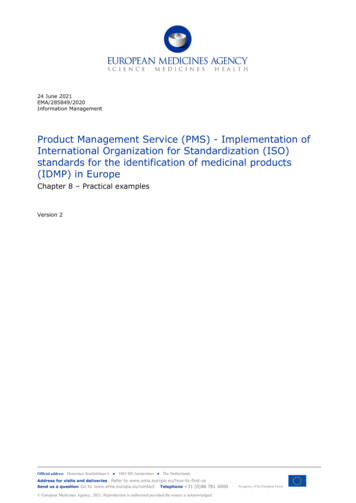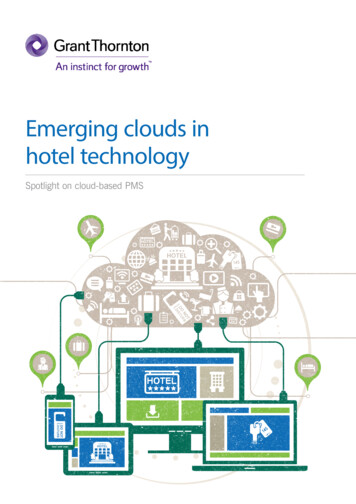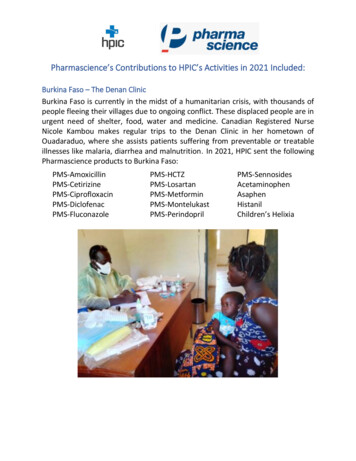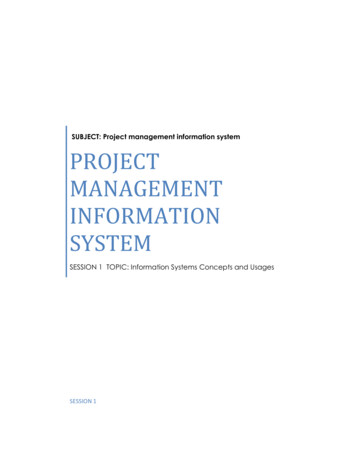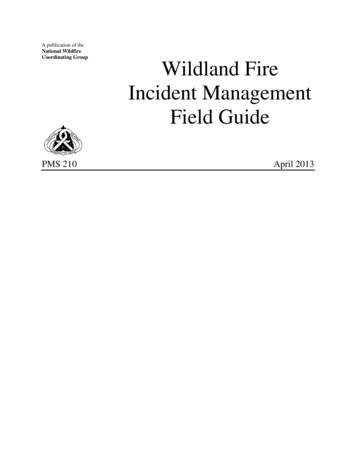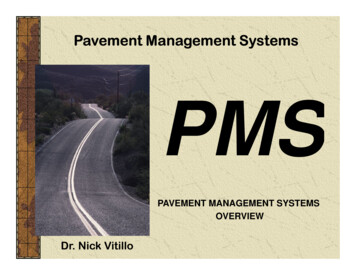
Transcription
24 June 2021EMA/795140/2018Information ManagementProduct Management Services (PMS) - Implementation ofInternational Organization for Standardization (ISO)standards for the identification of medicinal products(IDMP) in EuropeChapter 3: Process for the electronic submission of medicinal productsinformationVersion 2Official address Domenico Scarlattilaan 6 1083 HS Amsterdam The NetherlandsAddress for visits and deliveries Refer to www.ema.europa.eu/how-to-find-usSend us a question Go to www.ema.europa.eu/contactTelephone 31 (0)88 781 6000 European Medicines Agency, 2021. Reproduction is authorised provided the source is acknowledged.An agency of the European Union
Table of contentsSummary of changes . 41. Introduction . 61.1. Target Operating Model (TOM) . 61.2. Stepwise approach for PMS Implementation . 71.2.1. Implementation Step 1: Applicable to centralised authorisation procedureonly . 71.2.2. Implementation Step 2: Applicable to all regulatory authorisationprocedures. . 101.3. Submission implementation plan . 121.4. Submission operations and end-to-end data processes . 132. Step 1 - Initial submission of an authorised medicinal product (AMP) . 153. Step 1 - Maintenance submissions of an authorised medicinal product (AMP) . 173.1. Submission options after review of migrated data for already authorisedmedicinal products . 173.2. Maintenance of centrally authorised products . 193.3. Maintenance of non-centrally authorised products . 203.3.1. Submission timelines following a variation procedure for non-CAPs . 213.4. Submission of notifications for CAPs and non-CAPs . 223.4.1. Qualified Person responsible for Pharmacovigilance (QPPV) . 233.4.2. Pharmacovigilance System Master File Location (PSMFL) . 243.4.3. Contact information for Pharmacovigilance enquiries . 253.4.4. Information on Marketing Status . 253.4.5. Authorisation status change triggered by competent authorities . 253.4.6. Data carrier identifier . 253.5. Enrichment submissions for CAPs and non-CAPs . 263.5.1. Full enrichment submission . 263.5.2. Partial enrichment submission . 273.6. Nullification of medicinal product entities in PMS for CAPs and non-CAPs . 27Annex I: Overview of submission processes . 28Annex II: Initial submission process for CAPs . 29Annex III: Lifecycle submissions examples for a CAP medicinal product . 30Annex IV: Activities to be performed after review of the migrated data in PMS . 33Product Management Services (PMS) - Implementation of International Organization forStandardization (ISO) standards for the identification of medicinal products (IDMP) in EuropeEMA/795140/2018Page 2/34
Product Management Services (PMS) - Implementation of International Organization forStandardization (ISO) standards for the identification of medicinal products (IDMP) in EuropeEMA/795140/2018Page 3/34
Summary of changesFollowing the publication of version 1.0 of this document in February 2021, the content of the belowlisted sections was amended as follows: Section 1. Introduction: Figure 1 has been updated to provide clearer representation of the overall process forsubmission of medicinal product data, the preconditions for the submission to PMS during Step 1 explained in section 1.2.1.1 havebeen rephrased to give more clarity to readers, section 1.2.1.2 now contains more information regarding the submission of data to PMS forCAPs medicinal products; Figure 2 has also been improved, information regarding the non-CAPs submissions has also been improved in section 1.2.1.3,editorial changes have been included in section 1.2.2 and Figure 4 has been improved for abetter understanding, sections 1.3 and 1.4 have been updated with editorial changes;Section 2. Step 1 – Initial submission of an authorised medicinal product: the section where the process of the submission of CAP data is explained has been updated inthis new version; additional information is provided, the non-CAP section has only been updated with editorial changes;Section 3. Step 1 – Maintenance submissions of an authorised medicinal product:-this section has been considerably updated in order to provide more information of thedifferent types of data submissions to PMS depending on the type of changes or the dataelements to be updated,-section 3.1 now contains the three different scenarios that can be followed after revision ofmigrated data by EMA to PMS. Even though more information is provided in this version of theChapter, additional information will be provided in due course,-section 3.2 now explains in a more structured way the process to maintain data in PMS forCAPs and Figure 7 has been included for reference,-section 3.3 (for non-CAPs) contains only editorial changes,-section 3.4, which is dedicated to notifications, now contains subsections to captureinformation regarding the PV enquiry information (3.4.3), Marketing Status information (3.4.4)and changes to Authorisation Status triggered by Cas (3.4.5),-previous section of 'Amendments' has been deleted as now this information should be providedas part of maintenance activities or partial enrichments,-section 3.5 has been updated to reflect the change described in the previous bullet point andnow there are two types of enrichments: full enrichments (section 3.5.1) and partialenrichments (section 3.5.2),Product Management Services (PMS) - Implementation of International Organization forStandardization (ISO) standards for the identification of medicinal products (IDMP) in EuropeEMA/795140/2018Page 4/34
Annexes: Annex I: Overview of submission process: this annex has been included to provide a decisiontree with the different submission types and the link to the specific sections in this Chapter, Annex II: Initial submission process for CAPs: an example of an Initial MAA is described in thisannex, Annex III: Lifecycle submissions examples for a CAP medicinal product: this annex providesseveral examples and the explanation of how data should be provided to PMS for differentprocedures of the lifecycle of a medicinal product, Annex IV: Activities to be performed after review for the migrated data in PMS: this annex isrelated to section 3.1 where the different scenarios to be followed by an MAH/applicant afterreview of the migrated data. Several examples are provided in this annex in order to clarify theprocess to readers.Product Management Services (PMS) - Implementation of International Organization forStandardization (ISO) standards for the identification of medicinal products (IDMP) in EuropeEMA/795140/2018Page 5/34
1. IntroductionThis chapter provides guidance on the process governing the electronic submission of human medicinalproducts in the European Economic Area (EEA), in accordance with ISO IDMP standards i.e. using theFHIR message containing PMS data.This guidance covers the entire process from the initial submission of the marketing authorisationapplication, to the maintenance activities (e.g. variations and renewals) performed during the lifecycleof the medicinal product. This guidance also covers the process to provide new data or to correct dataof already authorised medicinal products.ISO IDMP standards specify the use of standardised definitions and structures for the identification anddescription of medicinal products for human use. The use of ISO IDMP is required in accordance withArticles 25 and 26 of Commission Implementing Regulation (EU) No 520/2012. These provisionsmandate Member States, marketing authorisation holders and the European Medicines Agency (EMA)to use ISO IDMP standards for the exchange and communication of information on medicinal product.The Article 57(2) of Regulation (EC) No 726/2004, as amended by Regulation (EU) 1235/2010 andRegulation (EU) 1027/2012, requires: the Agency to publish the format for the electronic submission of information on medicinal productsfor human use by 2 July 2011; marketing authorisation holders to submit information to the Agency electronically on all medicinalproducts for human use authorised in the European Union by 2 July 2012, using this format;marketing authorisation holders to inform the Agency of any new or varied marketingauthorisations granted in the EU as of 2 July 2012, using this format.1.1. Target Operating Model (TOM)The Target Operating Model is a business process model to ensure high data quality and consistencyand to optimise the exchange of medicinal product data between regulators and applicants.The overall goal of the EU TOM is to integrate the submission of medicinal product data as referred toin the Article 57(2) of Regulation (EC) No 726/2004 with the applicable regulatory activities (includingthe activities of validation, assessment and approvals).The implementation of the TOM and the use of PMS is expected to benefit the following areas: enable the digital transformation of the EU Network regulatory activities reducing administrativeburdens; harmonise data governance processes for management of medicines data and documents resultingin: higher quality of data fulfilling different regulatory and non-regulatory needs, enhancing data interoperability and data re-usability, minimizing data maintenance costs.PMS implementation follows a stepwise approach as described in the following section.Product Management Services (PMS) - Implementation of International Organization forStandardization (ISO) standards for the identification of medicinal products (IDMP) in EuropeEMA/795140/2018Page 6/34
1.2. Stepwise approach for PMS Implementation1.2.1. Implementation Step 1: Applicable to centralised authorisationprocedure onlyIn Step 1 of the implementation, the process for the submission of medicinal product data variesdepending on the type of procedure under which the marketing authorisation has been or is expectedto be granted and as presented in figure 1.Figure 1 – Implementation Step 1 – Overall process for submission of medicinal productdata1.2.1.1. Preconditions for PMS submissions during Step 1 Marketing authorisation holders must be able to generate FHIR messages to comply with theirregulatory obligations under Article 57 of Regulation 726/2004. A User Interface (UI) will be madeavailable to support companies to comply with this precondition. It is the MAH’s decision to switch from XEVPRM format to the FHIR format. This transition can bedone for either the entire CAP portfolio only or for the complete portfolio (i.e. CPs, MRPs, DCPs andNPs). It is not possible to switch only for one of the non-CAP procedures, (MRP, DCP or NP) or forcertain products. Transition can be done initially for CAPs and include the rest of the portfolio (i.e.non-CAPs) afterwards.The process to request to switch from one format to the new one will be described in furtherversions of the EU IG. Access to PMS should have been granted and tested for each MAH/Applicant.Product Management Services (PMS) - Implementation of International Organization forStandardization (ISO) standards for the identification of medicinal products (IDMP) in EuropeEMA/795140/2018Page 7/34
1.2.1.2. Centrally authorised medicinal products (CAPs)As described in section 1.2.1. Stepwise approach for PMS Implementation, in Step 1, the PMS TOM willbe transitionally implemented for medicinal products authorised under centralised authorisationprocedure only.PMS TOM integrates the requirements for the electronic submission of medicinal product information asper Article 57(2) legal obligations with the applicable regulatory activities.When the relevant preconditions are met, marketing authorisation holders can submit the new FHIRformat together with their regulatory submissions and the product dataset, which will undergovalidation by EMA during centralised authorisation procedure. The decision will affect the entire MAH’sCAP portfolio and the submission via XEVPRM will be disabled once the registration for the submissionvia FHIR message is fulfilled by the MAH.As indicated in Figure 2, whenever the regulatory submission is based on eCTD format, the FHIRmessage must be included together with the dossier, in the working documents folder. If, after theapproval of the regulatory procedure, a closing sequence in eCTD is not provided, the FHIR messagecontaining the approved information should be provided directly to PMS via the API as described inChapter 6 – SPOR API Specification. Same submission process should be followed for regulatorysubmissions not based on eCTD. This submission through the API should be done if no closingsequence is provided, as EMA needs to know which is the last version of the FHIR that can be used forPMS purposes. More information of each submission process is provided in the following sections of thisChapter and an overview can be found in Annex I. Overview of submission process.Figure 2 – Implementation Step 1 - Process for submission of centrally authorised medicinalproduct dataProduct Management Services (PMS) - Implementation of International Organization forStandardization (ISO) standards for the identification of medicinal products (IDMP) in EuropeEMA/795140/2018Page 8/34
As indicated in section 1.3. Submission implementation plan, during Step 1, there will be a transitionperiod from the Go-Live of PMS until PMS is enforced for CAPs. During this period, MAHs can decidewhether they submit the product dataset using XEVPRM or FHIR format. At an agreed timeline, EMAwill decommission the XEVPRM format for CAPs and the new FHIR format will become mandatory tocomply with Article 57 data submission requirements.Although high-level details of implementation are provided in section 1.3. Submission implementationplan, for awareness purposes, EMA will publish a separate implementation plan before the start of thephase.1.2.1.3. Non centrally authorised medicinal products (non-CAPs)For medicinal products not authorised via the centralised procedure, that is, authorised through mutualrecognition procedures (MRPs), decentralised procedures (DCPs) and pure national procedures (NPs)(i.e. "non-CAPs"), marketing authorisation holders may continue to submit data on authorisedmedicines in the XEVPRM format, in line with the processes and specification described in Art.57Detailed guidance documentation.As indicated in Figure 3, when the relevant preconditions are met, marketing authorisation holders canchoose to switch from the current submission format (XEVPRM) to the new FHIR format to comply withtheir regulatory obligations under Article 57 of Regulation 726/2004. The decision will affect the entireMAH’s non-CAP portfolio and the submission via XEVPRM will be disabled once the registration for thesubmission via FHIR message is fulfilled by the MAH.In this case, marketing authorisation holders can submit the FHIR dataset together with theirregulatory submissions (i.e. within the eCTD dossier), although it will not be assessed by the relevantcompetent authority during the procedure. This option is not shown in Figure 3.If the MAH has chosen to submit non-centrally authorised medicinal products information via FHIR,following completion of the regulatory procedure, a FHIR message shall be posted directly in PMS viathe API as described in EU IG Chapter 6 – SPOR API Specification. More information about the differentprocesses can be found in the following sections of this Chapter. Moreover, an overview can be foundin Annex I. Overview of submission process.Transition to the new format is completely optional for non-CAPs medicinal products and submissionsto PMS are allowed so MAHs can harmonize internal processes. As indicated in section 2. Initialsubmission of authorised medicinal product, for non-CAPs, the data provided within the FHIR messagewill be fed-back to Art. 57 where they will be subject to the quality control (QC).The timelines of the implementation and enforcement of the above-mentioned processes are describedin section 1.3. Submission implementation plan.Product Management Services (PMS) - Implementation of International Organization forStandardization (ISO) standards for the identification of medicinal products (IDMP) in EuropeEMA/795140/2018Page 9/34
Figure 3 – Implementation Step 1 - Process for submission of non-centrally authorisedmedicinal product data1.2.2. Implementation Step 2: Applicable to all regulatory authorisationprocedures.In Step 2, the TOM will be implemented for medicinal products authorised under all regulatoryauthorisation procedures (e.g. national, mutual, decentralised and centralised procedures).TOM integrates the requirements for the electronic submission of medicinal product information as perArticle 57(2) legal obligations with the applicable regulatory activities. Preconditions: The full implementation of the PMS TOM relies on the availability of the followingcomponents: -a new version of the EU IG supporting the implementation of Step 2 and reflecting the latestagreements and details available,-a structured application form solution that is compatible with the data model described in IDMPstandards enabling submissions of medicinal product data into PMS repository,-a shared EU data governance framework aimed at defining roles and responsibilities for datamaintenance and management including aspects related to data validation processes in thecontext of the regulatory assessment,-capabilities of issuing exchanging and maintaining medicinal product identifiers across the EUregulatory network;Process: where applicable, MAH/applicant shall submit the medicinal product data within theapplication form (eAF) dataset together with the eCTD for a specific regulatory procedure.Therefore, the TOM process aligns the electronic submission of the medicinal product data asrequired by the Article 57(2) provision with the regulatory activities.Product Management Services (PMS) - Implementation of International Organization forStandardization (ISO) standards for the identification of medicinal products (IDMP) in EuropeEMA/795140/2018Page 10/34
In addition, direct submission via API of FHIR message into PMS database is established to allowthe maintenance of medicinal product data that is triggered by regulatory procedures not requiringeCTD submissions (e.g. notification of changes to the QPPV and pharmacovigilance enquiryinformation, expiry due to sunset clause) or regulatory activities where a closing sequence is notprovided; Standard/Format: the application form (eAF) dataset containing relevant medicinal productinformation shall be generated by applicant/marketing authorisation holder as reflected in EU IGChapter 2 - Initial Submission; Data Validation: the Assessor(s) of the competent authority will review the structured applicationform encompassing the product FHIR message provided by the MAH or applicant to make sure thedata provided is in line with the one submitted within the dossier considering that the dossier is theauthoritative source of data. Once the regulatory procedure is completed, the FHIR messagecontaining the approved data is loaded in the PMS database. Additional information on data qualitymeasures and principles will be outlined in Chapter 4 Data Quality assurance.Figure 4 – Implementation Step 2 – Overall process for submission of medicinal productdataProduct Management Services (PMS) - Implementation of International Organization forStandardization (ISO) standards for the identification of medicinal products (IDMP) in EuropeEMA/795140/2018Page 11/34
1.3. Submission implementation planThis section provides timelines for key milestones enabling the submission of medicinal product datasetusing FHIR based message in EU. Specifically, this version focuses at the plan for the Step 1 of theimplementation of the TOM for CAPs as defined in section 1.2.1. Implementation Step 1: Applicable tocentralised authorisation procedure only.The implementation of Step 1 is outlined in Figure 5 and planned as follows:Figure 5 – Submission implementation plan In Q1 2021 the ISO IDMP EU Implementation Guide version 2 (EU IG v2.0) has been publisheddefining the processes, formats and technical specifications to comply with the Article 57(2) ofRegulation (EC) 726/2004 requirements. EU IG v2.0 is the basis for medicinal product dataexchange in the EU and therefore enables the European medicines regulatory network to preparefor implementation of PMS Step 1. Following the publication of EU IG v2.0 the European medicines regulatory network is expected tohave a minimum twelve-month period to prepare for implementation. During that period EMA willprovide a detailed implementation plan, as well as a separate go-live announcement which will beagreed with the Network. With PMS go live, when Step 1 commences, the PMS database will be able to receive informationand data supplied via the formats and processes outlined in section 1.2.1. Implementation Step 1:Applicable to centralised authorisation procedure only. Within this period, MAH can voluntarilytransition from submission with XEVPRM type of message to FHIR type for both CAPs and NonCAPs.Product Management Services (PMS) - Implementation of International Organization forStandardization (ISO) standards for the identification of medicinal products (IDMP) in EuropeEMA/795140/2018Page 12/34
The European medicines regulatory network is expected to have another minimum twelve-monthperiod to prepare for enforcement for centrally authorised products, whereby the new FHIR formatwill become mandatory to comply with Article 57 data submission requirements. Step 2 is expected to start when the conditions referred in 1.2.2. are met. Therefore, a separatego-live announcement is also expected. Marketing authorisation holders are expected to submit thenew product dataset (as part of the application form) together with their regulatory submissionsand the product dataset will be assessed by the relevant competent authority during the regulatoryprocedure. On an agreed timeline, to comply with Article 57 data submission requirements, thenew FHIR format will become mandatory for all procedures. While it is desirable that this enforcement coincides with the Step 2 these are separate decisionsand events. Discussion is ongoing and a balance is to be found between extending the transitionperiod, triggering new use cases or supporting Step 2. EMA will provide a detailed plan, specifyingwhat data to submit and when the new format will become mandatory, twelve months in advanceof any change.1.4. Submission operations and end-to-end data processesApplicants or marketing authorisation holders shall notify the Agency about new marketingauthorisation applications, newly authorised medicinal product or changes to the terms of marketingauthorisations of already submitted medicinal products as applicable.The electronic submission of medicinal product information can be performed in one of the followingmanners as applicable: by submission in the eCTD package of a FHIR message as applicable (i.e. for notification of CAPsinformation as outlined in paragraph 1.2.1. Implementation Step 1: Applicable to centralisedauthorisation procedure only); via an Application Programming Interface (API), which enables machine to machine exchange ofinformation and in line with the specification defined in the EU IG Chapter 6 – SPOR APISpecification; by User Interface (UI) which enables users to manage the relevant medicinal product data.Sections 6.4 and 7, respectively, of the EU IG Chapter 6 – SPOR API Specification describe thetechnical specification of the data management operations (i.e. endpoints) as well as the supportedFHIR message format. As described in this document, API submissions are required in the followingsituations: initial marketing authorisations or line extensions: only for non-centrally authorised products andafter the MAA has been granted; maintenance activities: submission through the API depends on the type of procedure and type ofmaintenance as follows: centrally authorised medicinal products: submission through the API should be done only if noclosing sequence is provided once the regulatory procedure is finished. Notifications asdescribed in section 3.4. and enrichment submissions (3.5.) shall be done as well through theAPI, non-centrally authorised medicinal products: during Step 1, every maintenance submission isdone through the API.Product Management Services (PMS) - Implementation of International Organization forStandardization (ISO) standards for the identification of medicinal products (IDMP) in EuropeEMA/795140/2018Page 13/34
Specifically, for the PMS API submissions, the following operations apply: submission of new medicinal product (EP309 Create Product) record must be fulfilled to notifyinformation to newly authorised medicinal product or changes to the term of the marketingauthorisation that trigger a new PMS ID according to the criteria specified in section Definingcharacteristics of a medicinal product of Chapter 2 of the EU ISO IDMP IG. One marketingauthorisation can trigger multiple PMS IDs. Specifically, this operation type must be used in thefollowing circumstances: notification of the new medicinal product for which a marketing authorisation has been grantedby the competent authority (i.e. Initial submission of medicinal product), extension to the terms of marketing authorisation (e.g. changes to the qualitative andquantitative composition for inclusion of new active substance/adjuvant, changes of thestrength/potency, addition of authorised/administrable pharmaceutical form and routes ofadministration where the NCA issues a new marketing authorisation number); an update of an existing medicinal product (EP311 Update Product) record must be fulfilled to: amend medicinal product structured and unstructured product data due to changes to theterms of the marketing authorisation as part of a regulatory procedures (e.g. variations), notify any changes to the structured and unstructured product data which is not triggered by aregulatory procedure e.g. changes to the QPPV, pharmacovigilance enquiries and location ofthe Pharmacovigilance System Master File (PSMFL), edit incorrectly submitted information (e.g. typos, misspellings and information submitted bymistake), enrich and complete data previously submitted with the XEVPRM format;a nullification of a medicinal product entry must be used to remove any erroneous medicinalproduct data previously submitted in PMS (e.g. duplicated entities or entities providederroneously).Product Management Services (PMS) - Implementation of International Organization forStandardization (ISO) standards for the identification of medicinal products (IDMP) in EuropeEMA/795140/2018Page 14/34
2. Step 1 - Initial submission of an authorised medicinalproduct (AMP)This section provides further details on the process for the initial submission of medicinal productsinformation by marketing authorisation holders in accordance with point (b) of Article 57(2) ofRegulation (EC) 726/2004 during Step 1.This section covers the initial submission of marketing authorisation applications and line extensions.In essence, applications that will trigger the generation of new business IDs (i.e. PMS ID(s), MPID(s)and PCID(s)) based on the defining elements described in Chapter 2 of the EU IG. Process: As described in section 1.2.1. Implementation Step 1: Applicable to centralisedauthorisation procedure only, the submission process differs depending on the procedure for whichthe marketing authorisation of a medicinal product authorisation will be granted and as follow: For centrally authorised products (CAPs):Current eCTD submission process is to be followed, and this guidance has no impact on it. TheFHIR dataset has to be submitted electronically to the Agency in the eCTD working documentsfolder as part of the initial submission. Temporary technical FHIR IDs are needed to bundle theFHIR resources and express the relationship between them. These technical FHIR IDs must becreated by the system used to generate the FHIR dataset.Initial sequence must contain the full dataset in FHIR format. For validation purposes,subsequent sequences for the initial marketing authorisation application or line extension (i.evalidation sequence, responses to questions sequences and closing sequence) shall contain thefull FHIR dataset (submission of deltas is not allowed during initial submissions). The FHIRdataset should be provided during the assessment process when, as part of the assessment,the MAH or applicant updates data which is part of the FHIR dataset (e.g. indication text). Ifupdates are done to data which is not part of the FHIR dataset (e.g. new clinical study), it shallnot be provided.Closing sequence must contain the full FHIR dataset with the approved data. The datasetprovided with the closing sequence will
Information Management . Product Management Services (PMS) - Implementation of International Organization for Standardization (ISO) standards for the identification of medicinal products (IDMP) in Europe . Chapter 3: Process for the electronic submission of medicinal products information . Version 2


